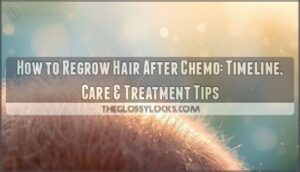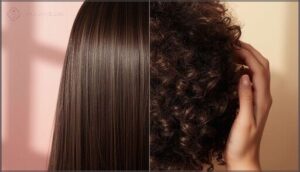This site is supported by our readers. We may earn a commission, at no cost to you, if you purchase through links.
The first wispy strands of hair appearing on your scalp after chemotherapy represent more than regrowth—they signal your body reclaiming its rhythm. Most patients notice soft peach fuzz emerging three to four weeks after their final treatment, though the journey from those initial colorless wisps to a full head of hair spans six to twelve months.
Your regrowth speed depends on multiple factors, including the specific chemotherapy drugs you received, your age, and your nutritional status. Taxane-based regimens can slow the process by up to eight times compared to other treatments.
Understanding what accelerates or hinders regrowth helps you support your body through each stage, from that first stubble to the moment you recognize yourself in the mirror again.
Table Of Contents
- Key Takeaways
- Timeline for Hair Regrowth After Chemotherapy
- Nurturing Your Scalp for Optimal Hair Regrowth
- Essential Nutrients to Support Hair Regrowth
- Gentle Hair Care Practices During Regrowth
- Dealing With Changes in Hair Texture
- Medications and Treatments to Boost Regrowth
- Managing Expectations During Hair Regrowth Process
- Natural Remedies to Promote Hair Regrowth
- Styling Options During Different Regrowth Stages
- When to Consult a Healthcare Professional
- Frequently Asked Questions (FAQs)
- What helps hair grow back faster after chemo?
- Can hair loss from chemo be reversed?
- What food is good for hair growth after chemo?
- How to remove chemo hair stubble?
- Can stress affect hair regrowth after chemotherapy?
- Are there specific hairstyles to avoid during regrowth?
- How does age impact hair regrowth post-chemo?
- Can certain medications interfere with hair regrowth?
- Is it safe to color regrowing hair?
- Can chemotherapy cause permanent hair loss?
- Conclusion
Key Takeaways
- Most patients see soft peach fuzz emerge 3-4 weeks after their final chemotherapy treatment, with recognizable coverage developing within 6-12 months, though full density may take longer and texture often changes unpredictably.
- Your regrowth speed depends heavily on the specific chemotherapy drugs you received—taxane-based regimens can slow the process up to eight times compared to other treatments—along with factors like age, nutrition, and overall health.
- Gentle scalp care makes a real difference: use sulfate-free shampoos only 2-3 times weekly, try daily fingertip massage for 4-5 minutes to boost blood flow, protect your scalp from UV rays, and avoid heat styling or chemical treatments for at least six months.
- While 98% of patients experience some regrowth, about 30% notice thinner hair even years later, and certain medications like topical minoxidil or scalp cooling during treatment can support faster, fuller recovery when discussed with your oncology team.
Timeline for Hair Regrowth After Chemotherapy
Your hair won’t come back overnight, but it will come back. Most people see the first signs of regrowth within a few weeks after their final treatment, though the process unfolds in stages over several months.
Here’s what you can expect as your hair makes its comeback.
Initial Signs of Hair Regrowth
Your first victory appears about 3–4 weeks after your last treatment, when soft peach fuzz emerges—the earliest sign of hair follicle repair. You might notice scalp sensitivity or tingling as dormant follicles wake up. These initial hairs often look colorless or wispy, marking early regrowth signs that signal recovery.
Don’t expect uniformity; fuzz formation follows unpredictable regrowth patterns across your scalp. Some patients even spot these changes before chemotherapy fully ends—proof that your body’s already fighting back.
Understanding the hair regrowth process is vital for managing expectations during this period.
Stages of Hair Regrowth
Once those initial signs appear, your hair regrowth timeline unfolds in predictable growth phases. Here’s what to expect:
- Weeks 2–8: Soft peach fuzz covers your scalp as hair follicles restart
- Months 2–3: You’ll have about 1 inch of thicker hair, enough to cover bare spots
- Months 3–6: Hair reaches 2–3 inches with noticeable regrowth patterns emerging
- Months 6–12: You’ll grow 4–6 inches, with improving hair texture and scalp health
- Year 1+: Near-complete coverage returns, though density may still be recovering
Understanding the effects of chemo hair loss is essential for managing expectations during the regrowth process.
Factors Affecting Regrowth Speed
Your chemotherapy dose and specific drugs have the biggest say in regrowth speed—taxane-based regimens can slow things down eight times more than other treatments.
Age matters too; older patients often see delayed hair follicle stimulation. Hormonal impact from menopause or existing thinning compounds the challenge, while conditions like diabetes can stall regrowth patterns by disrupting signals your scalp health depends on.
Expected Timeline for Full Regrowth
Most patients see recognizable coverage within 6–12 months after their last treatment, though your hair density may not match what you’d had before. About 98% of patients report some regrowth, but recovery rates vary—roughly 30% still notice thinner hair even five years out.
Your follicle health and specific regimen shape these regrowth patterns. Growth phases restart gradually, so hair regrowth and recovery unfold at your body’s pace, not a fixed schedule.
Nurturing Your Scalp for Optimal Hair Regrowth
Your scalp has been through battle, and now it needs you to become its fiercest advocate. After chemotherapy damages hair follicles, the right scalp care can make all the difference in how quickly and healthily your hair returns.
After chemotherapy damages your hair follicles, the right scalp care can make all the difference in how quickly and healthily your hair returns
Start with gentle cleansing—use mild, sulfate-free shampoos only two to three times per week. Your scalp is more sensitive than ever, so skip the vigorous rubbing and pat dry instead. Between washes, try a simple scalp massage: just four to five minutes of light fingertip circles daily can boost blood flow and potentially thicken new hair growth.
Protect that vulnerable skin from UV rays with hats or scarves when you’re outside, and apply a broad-spectrum sunscreen to any exposed areas. Keep your scalp hydrated with fragrance-free moisturizers or light plant oils to combat dryness and itching.
Some people find success with topical minoxidil to speed regrowth, but always check with your oncologist first—this is your journey, and your care team should guide every step.
Essential Nutrients to Support Hair Regrowth
What you eat plays a direct role in how well your hair regrows after chemotherapy. Your body needs specific nutrients to rebuild healthy hair follicles and support new growth.
Let’s look at the key nutrients that can help your hair come back stronger.
Protein-Rich Foods for Hair Growth
Protein powers your hair follicles like nothing else—it’s the raw material for keratin, the protein that literally builds each strand from the root up. You need about 1.2-2.0 grams per kilogram of your body weight daily for ideal hair regrowth after treatment. Here’s how to get it:
- Egg Benefits: Two eggs daily deliver 12 grams of protein plus biotin for hair growth
- Fish Protein: Salmon and tuna provide 25-29 grams per serving with inflammation-fighting omega-3s
- Plant Options: Lentils, quinoa, and beans offer complete nutritional support for hair health without meat
Vitamins and Minerals for Hair Health
Your hair follicles crave specific nutrients to bounce back after treatment. Vitamin D benefits hair health—aim for levels above 30 ng/mL, as deficiency appears in over 80% of patients with hair loss.
Iron supplements help when ferritin drops below 40 µg/L, though biotin deficiency is rare despite its popularity.
Zinc intake promotes cell division for hair regrowth, but watch selenium balance—too much actually causes hair loss instead of preventing it.
Omega-3 Fatty Acids and Hair Regrowth
Think of omega-3 fatty acids as fuel for your hair growth cycle after chemotherapy and hair loss. These nutrients combat inflammation around follicles while supporting the cells that drive hair regrowth after chemotherapy.
Fatty fish like salmon delivers the richest omega-3 benefits—aim for two servings weekly. Fish oil therapy or supplements offer alternatives, though some individuals experience better hair growth with whole-food sources like walnuts and flaxseeds.
Hydration and Its Impact on Hair
Your body needs proper fluid balance to support hair follicle health during regrowth after chemotherapy. Adequate water intake—around 8 to 10 glasses daily—helps maintain circulation to your scalp, delivering the nutrients and oxygen your hair follicles need for regeneration. Hydration therapy also keeps scalp moisture balanced, reducing dryness that can irritate sensitive skin.
Here’s how to enhance your fluid intake for hair care:
- Drink steadily throughout the day rather than forcing large amounts at once
- Include water-rich foods like cucumbers, watermelon, and leafy greens in your meals
- Try herbal teas or broths if plain water feels unappealing during recovery
When you’re well-hydrated, you’re creating the internal environment your hair follicles need to thrive during hair regrowth.
Gentle Hair Care Practices During Regrowth
Your new hair deserves a fresh start, and that means rethinking how you care for it. The regrowth phase is delicate—your scalp is still recovering, and your hair follicles are rebuilding strength from the ground up.
Here’s how to protect and nurture your hair as it comes back.
Choosing The Right Shampoo and Conditioner
When your scalp still tingles from treatment, choosing the right products becomes an act of self-care. You’ll want sulfate-free shampoos with a pH balance close to 5.5—these gentle formulas support your scalp’s barrier without stinging. Fragrance avoidance matters here; unscented products minimize irritation during hair regrowth. Look for labels stating “sensitive skin” or “dermatology-tested” to protect your recovering scalp while encouraging healthy hair growth after chemotherapy.
| Avoid These Ingredients | Choose These Instead |
|---|---|
| Sodium lauryl sulfate | Mild, sulfate-free surfactants |
| Strong fragrances & essential oils | Fragrance-free formulations |
| Parabens & harsh preservatives | Hypoallergenic, pH-balanced products |
| Heavy silicones | Light, silicone-free conditioners |
Proper Washing and Drying Techniques
Treating your regrowing strands with care protects what you’ve been waiting for. During hair regrowth, gentle shampooing twice weekly with lukewarm water prevents scalp dryness. Follow these steps for ideal hair care and maintenance:
- Massage shampoo using fingertips, never nails
- Rinse thoroughly with cool water
- Blot gently—no vigorous hair toweling
- Use a wide-toothed comb for wet combing
- Air-dry partially, then apply low heat styling if needed
This approach aids healthy hair growth while minimizing breakage.
Avoiding Heat Styling and Harsh Chemicals
Your newly growing hair can’t handle the heat or harsh treatments that seemed routine before. Research shows that temperatures above 140 degrees Celsius cause irreversible damage to hair structure, and post-chemo strands are especially vulnerable to breakage.
Skip blow-dryers, curling irons, and straighteners for now—these heat damage prevention steps protect what you’ve worked so hard to regrow.
Equally important: avoid dyes, perms, and chemical relaxers for at least six months, as your scalp needs time to recover its protective barrier.
Scalp Massage for Stimulating Growth
After avoiding harsh treatments, your fingertips become powerful allies. Gentle scalp massage increases blood flow to hair follicles and may even thicken individual strands—one study found daily four-minute sessions boosted shaft diameter over six months.
Use soft circular motions for 5–10 minutes daily, applying light pressure without tugging. Think of it as preparing soil before planting seeds. Your scalp’s still tender, so skip aggressive rubbing.
This simple practice complements treatments like minoxidil beautifully.
Dealing With Changes in Hair Texture
Your hair may come back different than before—curlier, straighter, thicker, or with a new texture altogether. These changes can feel surprising, but they’re a normal part of the regrowth process.
Here’s what you need to know about adapting to your new hair and when to get professional support.
Common Texture Changes After Chemotherapy
Your hair texture after chemotherapy can shift dramatically—what was once straight may now curl, while naturally curly hair might grow back straight or finer. About 65% of patients notice these changes, often called “chemo curls,” due to follicle damage altering hair shaft formation during regrowth patterns.
Common hair texture variations include:
- Tighter curls or waves appearing in previously straight hair
- Finer, more fragile strands despite seemingly fuller volume
- Softer, fluffier texture during early hair growth after chemotherapy
- Changes in both texture and color occurring simultaneously
- Slower-growing hair that feels more brittle than before
These chemotherapy side effects on hair follicles usually emerge during the first few months of regrowth.
Adapting Hair Care for New Textures
Once your hair starts coming back, it’s vital to align your routine with what’s actually growing. Chemotherapy side effects often bring unexpected hair texture changes—your formerly straight strands might now spiral into “chemo curls,” requiring new regrowth strategies to manage increased dryness and scalp sensitivity.
Here’s how to adjust your post-chemo products and hair care approach:
| Hair Texture | Key Challenge | Recommended Approach |
|---|---|---|
| Tight curls/coils | Dryness (up to 30% less natural oils) | Weekly deep conditioning masks with shea butter or argan oil |
| Loose waves | Frizz and tangling | Lightweight leave-in conditioners; sulfate-free cleansers |
| Fine/straight | Fragility and limpness | Gentle volumizing products; avoid heavy oils |
| Thick/coarse | Stiffness and friction | Extended conditioning time; smoothing serums |
| All textures | Scalp sensitivity | Baby shampoos or fragrance-free formulas for first 3–6 months |
For curl definition in new waves or coils, use humectant-rich leave-in treatments and detangle gently on damp hair with a wide-tooth comb, working from ends upward. This reduces breakage by 20–30% compared to dry combing.
If your hair loss recovery brings finer strands, skip heavy styling products that weigh down short regrowth. Blot—don’t rub—with microfiber towels to protect delicate hair growth, and sleep on silk or satin to minimize friction overnight.
Your oncologist or dermatologist can offer tailored guidance if you notice persistent thinning or marked texture asymmetry after six months.
Styling Tips for Different Hair Textures
Styling your new texture doesn’t require a degree in cosmetology—it just takes the right approach. For curly hair care after chemo, wash only once or twice weekly and scrunch in curl cream to define those “chemo curls” while they’re damp.
Fine hair styling works best with lightweight volumizing products and soft-bristle brushes to protect fragile hair follicles.
If coarse texture management is your challenge, emollient-rich conditioners and loose protective styles keep thick post-chemo styling manageable without excess tension on hair regrowth.
When to Seek Professional Hair Care
Beyond adapting to texture changes at home, professional guidance becomes essential when regrowth stalls or scalp issues persist. A dermatologist referral is warranted if you notice:
- Absent hair regrowth six months after chemotherapy ends
- Persistent scalp symptoms like redness, tenderness, or unusual patches
- Significant texture or density concerns that affect your confidence
- Questions about hair restoration treatments like minoxidil or specialized therapies
Your oncologist can coordinate a scalp assessment and connect you with dermatology experts for thorough post-chemo care.
Medications and Treatments to Boost Regrowth
While your body works hard to regrow hair naturally after chemo, certain medications and treatments can help speed things along. Some options are backed by solid research, while others show promise but need more study.
Here’s what you should know about the treatments that may support your hair’s return.
Minoxidil for Hair Regrowth After Chemo
If you’re wondering whether minoxidil can help your hair bounce back faster, the answer is encouraging. This over-the-counter treatment stimulates hair follicles and extends the growth phase, which matters after chemotherapy impact.
In clinical trials, patients using 2% minoxidil twice daily saw regrowth weeks earlier than those who didn’t. Minoxidil efficacy varies—pediatric studies show 87% of patients experienced improved hair density.
Your oncologist can guide minoxidil dosage and monitor regrowth patterns, helping you reclaim control over your hair growth journey.
Prescription Options for Hair Regrowth
When over-the-counter treatments don’t deliver the results you’re hoping for, prescription options can step in. Oral minoxidil at low doses (0.25–5 mg daily) has shown promise in case reports, while spironolactone (50–200 mg daily) may help some women restore hair density.
Bimatoprost, a prostaglandin analogue, targets eyelash regrowth with nearly 47% of patients responding at six months.
Emerging treatments like platelet-rich plasma and JAK inhibitors remain experimental—always discuss these with your oncologist first.
Scalp Cooling Systems During Chemotherapy
Scalp cooling devices might be your best shot at holding onto your hair during treatment. These systems—like the DigniCap Cooling System and Paxman caps—work by chilling your scalp to around 3–5°C, which restricts blood flow to hair follicles and shields them from chemotherapy drugs. In trials, about 50% of patients kept at least half their hair using cold cap therapy, compared with zero percent without cooling.
Here’s what matters most:
- Hair preservation methods work best with taxane-based regimens, showing around 59% success versus just 16% with anthracyclines
- Cooling starts 30–45 minutes before infusion and continues 60–150 minutes after
- Common side effects include headaches and scalp pain, though most people stick with treatment
The catch? Scalp cooling therapy adds 1–2 hours to each session, costs hundreds to thousands out-of-pocket, and doesn’t guarantee results. Still, many patients find chemotherapy-induced alopecia prevention worth the trade-off—especially when work and social life hang in the balance.
Low-Level Laser Therapy for Hair Growth
After cold caps, red light therapy offers another science-backed option. Low-level lasers use photobiomodulation—commonly 635–655 nm wavelengths—to jumpstart hair follicle stimulation and encourage regrowth after chemotherapy.
Animal studies show faster recovery, and FDA-cleared devices for pattern hair loss suggest promise for cancer treatment survivors.
You’ll need consistent sessions (10–30 minutes, several times weekly) for months to see results. It won’t work overnight, but laser hair growth therapy is safe and worth discussing with your oncologist.
Managing Expectations During Hair Regrowth Process
Hair regrowth after chemotherapy won’t happen overnight, and that’s okay. Your hair will come back at its own pace, and the journey might look different than you expected.
Understanding what to expect emotionally and practically can help you navigate this shift with more confidence and less frustration.
Emotional Aspects of Hair Regrowth
Emotional distress during hair regrowth is completely valid. Research shows that over half of chemotherapy patients rank hair loss among the most traumatic treatment effects, and body image concerns often persist even as hair returns. You’re experiencing a complex psychological impact that can affect self-perception and trigger social stigma.
To help manage this journey:
- Acknowledge that your feelings—frustration, grief, or hope—are all normal responses to cancer survivorship
- Connect with cancer patient support groups where others understand coping with chemotherapy hair loss firsthand
- Reframe visible regrowth milestones as evidence of your body’s exceptional resilience
- Seek professional counseling if distress about hair loss and regrowth interferes with daily functioning
Your emotional timeline for hair regrowth and restoration may not match the physical one, and that’s okay.
Coping Strategies for Slow Regrowth
When your hair regrowth and restoration feels frustratingly slow, resilience building becomes your anchor. Mindful coping means accepting this timeline without surrendering hope—research shows 98% of patients do regrow hair, though 4% experience slower recovery.
Join online communities where emotional support flows freely and hair loss acceptance develops naturally. Document your progress through journaling, transforming anxiety into a regrowth mindset.
Remember, hair growth and development can’t be rushed, but your coping with chemotherapy hair loss can evolve. These hair regrowth strategies protect your mental health during the wait.
Celebrating Milestones in Hair Regrowth
After building resilience through slow regrowth, recognize that each visible stage deserves acknowledgment. Keep a regrowth diary with weekly photos—studies show 73% of patients feel less self-confident initially, but documenting hair growth and development transforms anxiety into hope.
Your first public outing without a wig marks social reintegration. Create personal rituals around key markers, like scheduling your first professional haircut. These hair regrowth strategies support emotional recovery throughout chemotherapy and hair growth.
Natural Remedies to Promote Hair Regrowth
Natural remedies won’t replace medical treatments, but they can support your scalp’s healing environment as hair begins to return. Many people find comfort in using gentle, plant-based approaches alongside their recovery plan.
Here are some natural options you can explore with your healthcare team’s guidance.
Essential Oils for Scalp Health
Essential oils offer a natural way to support scalp health and hair regrowth after chemo. Rosemary benefits include boosting circulation, with studies showing it performs comparably to minoxidil for hair growth over six months. Tea tree oil addresses scalp inflammation and dandruff, creating a healthier environment for new growth. Lavender oil soothes sensitive skin while promoting follicle health.
For aromatherapy effects, dilute a few drops in a carrier oil—jojoba or grapeseed work well—and use gentle scalp massage techniques. This simple ritual nourishes your scalp and may accelerate hair regrowth, though patience remains key.
Herbal Supplements for Hair Growth
Natural supplements like Saw Palmetto and Ginseng Benefits are tempting options for hair regrowth, but caution is key. Small studies suggest Saw Palmetto may modestly boost hair density, while ginseng shows promise in supporting follicle health.
Curcumin Effects include reducing inflammation, though data specific to post-chemo hair restoration remains limited.
Before starting any nutraceutical, discuss Herbal Interactions and Nutraceutical Safety with your oncologist—some botanicals can interfere with cancer treatments or hormone-sensitive conditions.
Aloe Vera and Its Benefits
This plant-based remedy brings real relief to your post-chemotherapy scalp. Aloe vera gel delivers scalp hydration while reducing inflammation and irritation from treatment side effects.
Its enzymatic cleansing action gently removes dead cells blocking hair follicles, and antioxidant protection shields against damage during hair regrowth.
Apply the gel twice daily to soothe discomfort and create a healthier environment for hair growth after hair loss.
Scalp Exfoliation Techniques
Think of scalp exfoliation as clearing the path for new hair growth after hair loss. Gentle exfoliation removes dead cells and product buildup that can block follicles during hair regrowth.
Try a soft washcloth with mild shampoo or a brown sugar scrub mixed with oil—but only once weekly to protect sensitive skin. Skip chemical peels and exfoliating tools for now; your scalp needs tender care, not aggressive treatment. Always patch-test first.
Styling Options During Different Regrowth Stages
As your hair begins its comeback, you’ll move through different stages that each call for their own styling approach. The key is working with what you have at each phase rather than fighting against it.
Let’s walk through your options from those first wisps of fuzz all the way to your first real haircut.
Headwear Choices for Early Regrowth
During those first tender weeks of hair regrowth, your scalp needs protection more than fashion statements. Breathable fabrics like bamboo caps reduce heat and sweat by 30–40%, while soft cotton reduces irritation on treatment-sensitized skin.
Here’s what works best for early regrowth:
- Lightweight turbans – Pre-tied styles you won’t fumble with on exhausted mornings
- Wide-brimmed hats – Essential sun protection when hair density can’t shield your scalp
- Smooth caps – No rough stitching to irritate fragile new follicles
- Moisture-wicking liners – Wear under wigs to decrease friction and pressure points
Short Hairstyles for Growing Hair
When your hair reaches about 2 to 3 inches—usually around 3 to 6 months after treatment—pixie cuts and layered styles become your go-to options. Hair texturing helps disguise uneven hair regrowth, while face framing adds definition as your hair growth continues.
Short trims every 6 to 8 weeks keep your scalp comfortable and maintain shape during this in-between stage of hair loss recovery.
Techniques for Disguising Uneven Growth
When regrowth arrives in patches—center longer than the sides, or temples lagging behind—you’re not without options. Here’s how to balance things out:
- Hair Camouflage products like cosmetic fibers and scalp concealers visually fill sparse zones, especially along your part line.
- Wide headbands or bandanas cover shorter frontal areas while showing off longer sections.
- Color-matched tinted sprays reduce contrast between denser and thinner spots.
- Accessory styling with clips redirects eyes from patchy areas toward fuller growth.
Regrowth blending takes patience, but these techniques work.
When to Consider Your First Haircut
Once you’ve managed patchy areas, the question becomes: when should you book that first trim? Most people find their hair reaches 1 to 3 centimeters around 12 weeks after chemotherapy—enough for a shaping cut. By four to six months, you’ll often hit pixie length, a common marker in your regrowth timeline.
Before scheduling, check that your scalp sensitivity has eased and new strands feel sturdy, not brittle. A trim can tidy uneven edges and help you shift toward your preferred styling options. There’s no pressure—your post-chemotherapy hair care moves at your pace.
When to Consult a Healthcare Professional
Most people regrow their hair after chemotherapy without complications, but sometimes you need medical guidance to address concerns. Your healthcare team can help determine if what you’re experiencing is part of normal regrowth or requires attention.
Here are key situations when you should reach out to your oncologist or dermatologist.
Signs of Abnormal Hair Regrowth
While most people see soft fuzz within weeks of finishing treatment, certain Hair Loss Patterns signal it’s time to reach out to your oncology team. If you notice no visible Hair Regeneration by six months, or if Regrowth Delays extend beyond this window, schedule an evaluation.
Watch for Focal Alopecia—distinct bald patches with shiny, smooth skin that lack follicular openings—which differs from typical diffuse thinning. Persistent Hair Loss and Regrowth cycles, where hair continues shedding rather than stabilizing, warrant attention.
Abnormal Regrowth may also appear as ongoing miniaturization, with mostly thin, vellus-like hairs dominating your Regrowth Timeline instead of strong terminal growth.
Scalp Symptoms like burning, sensitivity, or visible inflammation alongside poor Follicle Stimulation require dermatologic assessment to rule out scarring alopecia or other conditions disrupting your Hair Growth Cycle.
Addressing Persistent Scalp Issues
Scalp Sensitivity that lingers for weeks or months after treatment deserves professional attention. Up to 65% of people experience ongoing scalp discomfort, including burning sensations, intense itching, or tenderness that disrupts daily life. When Hair Follicle irritation persists alongside unusual rashes, pustules, or crusting, these Chemotherapy Effects may signal Scalp Infections or Follicular Damage requiring targeted Hair Care interventions beyond standard regrowth support.
Consider reaching out when you notice:
- Painful or burning scalp sensations that interfere with wearing headwear or touching your Hair Regrowth
- Persistent red, inflamed patches with pustules clustering around follicles—these may need antibiotic treatment
- Severe itching accompanied by crusting or oozing that won’t respond to gentle moisturizers or Scalp Cooling relief
Evaluating The Need for Additional Treatment
Patience wears thin when six months pass without meaningful Hair Regrowth after Chemotherapy. That’s the Treatment Threshold when your Cancer Treatment team should evaluate whether your Hair Loss Assessment reveals persistent Chemotherapy-induced alopecia requiring Pharmacologic Interventions.
If your Regrowth Patterns show minimal improvement or patchy Hair Growth beyond this window, ask about Dermatologic Referral—you deserve active Hair Loss and Regrowth support, not endless waiting.
Discussing Concerns With Your Oncologist
When should you bring Hair Loss Concerns to your oncologist’s attention? The answer: always. Your Cancer Treatment team needs to hear about delayed regrowth, unexpected texture changes, or persistent scalp sensitivity—these aren’t trivial cosmetic complaints but legitimate Chemotherapy side effects requiring professional evaluation.
- Ask specific Oncologist Questions about your regrowth timeline based on your Cancer Therapy regimen
- Clarify Regrowth Expectations for your particular Chemotherapy Effects profile
- Request information on available Treatment Options like topical minoxidil or dermatology referrals
- Document any scalp pain, inflammation, or patchy growth patterns you’ve noticed
- Discuss emotional impacts openly—your Oncology team can connect you with supportive resources
Frequently Asked Questions (FAQs)
What helps hair grow back faster after chemo?
Here’s the irony: you can’t actually speed up hair regrowth—but your scalp care matters. Gentle massage boosts blood flow to hair follicles. During treatment, scalp cooling systems preserve follicles, shortening regrowth time.
Consider biotin supplements after consulting your care team. A balanced diet rich in protein, growth vitamins, and minerals aids chemotherapy recovery. Minoxidil treatment may help.
Patience remains essential—your hair will return, though texture may surprise you.
Can hair loss from chemo be reversed?
Good news: hair loss from chemotherapy is reversible for most people. About 98% of patients see regrowth within three to six months after treatment ends, though texture and color may change temporarily during your recovery journey.
What food is good for hair growth after chemo?
Your hair follicles need quality fuel to rebuild. Lean proteins like chicken, fish, eggs, and lentils deliver the building blocks, while iron-rich spinach and zinc from nuts support stronger regrowth after cancer treatment.
How to remove chemo hair stubble?
Use guarded clippers rather than blade razors to trim stubble safely—leaving 2-3 millimeters protects your scalp from nicks and folliculitis.
Warm washcloths can gently lift loose hairs without compromising skin integrity during chemotherapy.
Can stress affect hair regrowth after chemotherapy?
Like rain on a struggling garden, stress can dampen your hair regrowth after chemotherapy. Elevated cortisol levels may shorten growth phases and delay regrowth patterns.
Managing stress through relaxation techniques aids healthier hair follicle recovery.
Are there specific hairstyles to avoid during regrowth?
Yes, avoid tight ponytails, braids, and buns—they create hair tension that can trigger traction alopecia. Skip weaves, extensions, and chemical damage from relaxers or dyes.
Limit heat styling and heavy wig attachments on fragile regrowth.
How does age impact hair regrowth post-chemo?
Your age does influence how quickly hair regrows after chemotherapy. Younger patients often see faster, fuller regrowth within months, while older adults may experience slower recovery, thinner hair density, and more lasting texture changes.
Can certain medications interfere with hair regrowth?
Some medications can throw a wrench into your hair’s comeback story. Hormone therapies for breast or prostate cancer, certain antidepressants, blood thinners, and even high-dose retinoids may trigger drug-induced alopecia or slow regrowth markedly.
Is it safe to color regrowing hair?
Wait at least six months before coloring your regrowing hair. Post-chemo hair is fragile and sensitive to chemical reactions.
Choose gentler options like vegetable-based dyes, and always patch-test first to protect your delicate strands.
Can chemotherapy cause permanent hair loss?
Permanent alopecia can occur, particularly with taxane-based chemotherapy treatment. Studies show 12-42% of patients experience incomplete regrowth after cancer treatment.
Hair follicle damage depends on medication type, dosage, and individual factors affecting regrowth patterns.
Conclusion
Your body’s timing for how to regrow hair after chemo won’t match anyone else’s—and that’s exactly as it should be. The peach fuzz appearing today carries the same promise as that first morning you woke up without nausea.
Trust your scalp’s natural pace while giving it the nutrients, gentle care, and patience it deserves. Each new strand marks your body’s extraordinary ability to rebuild itself, one follicle at a time.

















